Bun Cha Ha Noi is more than just a dish; it's a glimpse into the soul of Hanoi's vibrant food culture. This delightful culinary offering features succulent grilled pork served alongside rice vermicelli noodles, fresh herbs, and a tangy dipping sauce known as nước chấm. The interplay of flavors, from the smoky richness of the grilled meat to the refreshing crunch of herbs, creates a sensory experience that captivates both locals and visitors. As you wander through the bustling streets of Hanoi, the tantalizing aroma of grilled pork wafts through the air, beckoning you to indulge in a bowl of this iconic dish. The cultural significance of Bun Cha extends beyond its delectable taste; it embodies the spirit of community and conviviality, often enjoyed in a relaxed setting among friends and family. In this article, we will delve into the ingredients, preparation methods, historical significance, and various regional renditions of Bun Cha Ha Noi, painting a comprehensive picture of this truly iconic Vietnamese culinary creation.
Bun Cha Ha Noi is a beloved traditional Vietnamese dish that originates from the capital city of Vietnam, Hanoi. It showcases a harmonious blend of flavors and textures that epitomize the essence of Vietnamese cuisine. The dish is typically composed of two main elements: grilled pork patties and grilled pork belly, both marinated to perfection and grilled over hot charcoal for that signature smoky flavor. Served alongside a bed of soft rice vermicelli noodles, fresh herbs, and a dipping sauce, Bun Cha invites diners to create their own perfect bites, offering a personalized dining experience that is both interactive and enjoyable. The vibrant colors of the fresh herbs and the tangy contrast of the dipping sauce complement the rich, savory pork, making every spoonful a celebration of taste. It is no wonder that Bun Cha has gained immense popularity, both locally and internationally, becoming emblematic of Hanoi's street food culture.
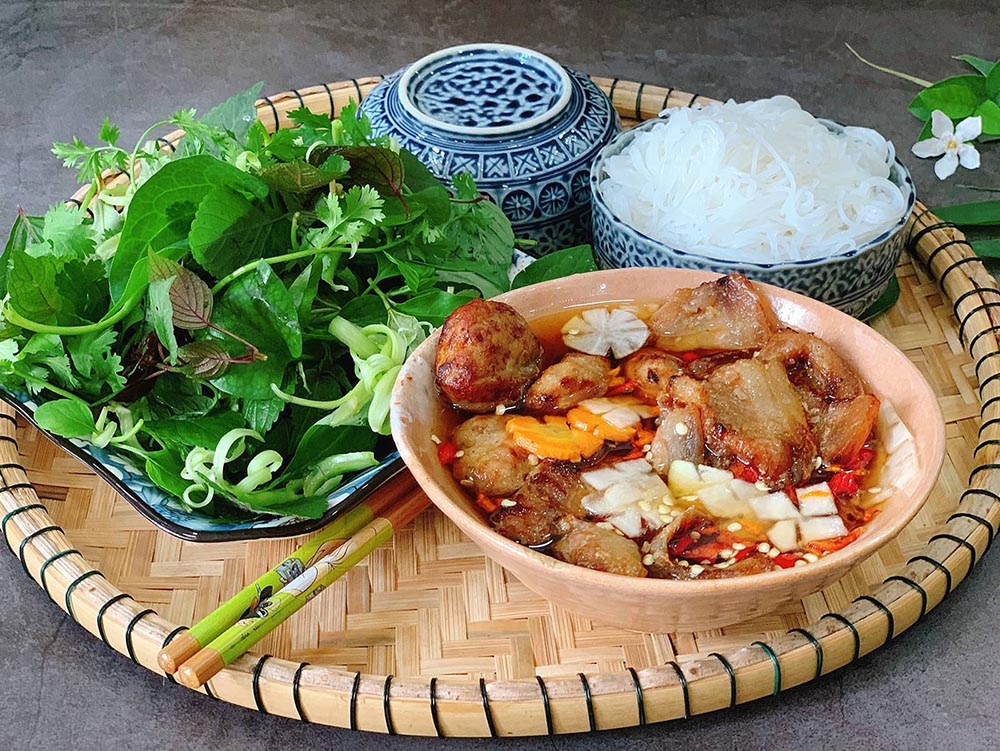
At the heart of every exceptional Bun Cha Ha Noi lies its meticulously chosen ingredients, each contributing to the overall flavor profile and ensuring an authentic culinary experience.
The grilled pork patties known locally as chả are a star component, made primarily from ground pork. They are seasoned with a blend of black pepper, sugar, fish sauce, grated onion, and kosher salt. This combination infuses the patties with a savory sweetness that balances perfectly when grilled over intense heat, resulting in succulent chunks of meat with a slightly caramelized exterior.
For the grilled pork belly, thin slices of pork are equally marinated with black pepper, sugar, fish sauce, and water before being grilled until crisp and flavorful. The richness of the pork belly pairs beautifully with the fresh herbs and vegetables, providing a satisfying textural contrast.
Vermicelli noodles play a crucial role in the dish, serving as a neutral base that allows the rich flavors of pork to shine. Typically, a 400-gram package of cooked vermicelli is used, adding just the right firmness to the bowl.
Garnishes and accompaniments elevate the Bun Cha experience:
Finally, the crowning feature nước chấm is a dipping sauce made from a delicate blend of vinegar, sugar, water, fish sauce, garlic, and chili peppers. Each ingredient is carefully balanced to create a flavor that is sweet, salty, and a touch spicy, bringing harmony to the overall dish.
| Ingredient | Purpose |
|---|---|
| Ground pork | Main protein component, seasoned for flavor |
| Pork belly | Adds richness and texture |
| Vermicelli noodles | Neutral base for the dish |
| Fresh herbs | Enhances freshness and flavor |
| Pickled vegetables | Provides tanginess and crunch |
| Nước chấm (dipping sauce) | Key flavor enhancer, combines sweet, salty, and sour elements |
This intricate assembly of ingredients is what makes Bun Cha Ha Noi a beloved dish, showcasing the complexity of Vietnamese culinary art.
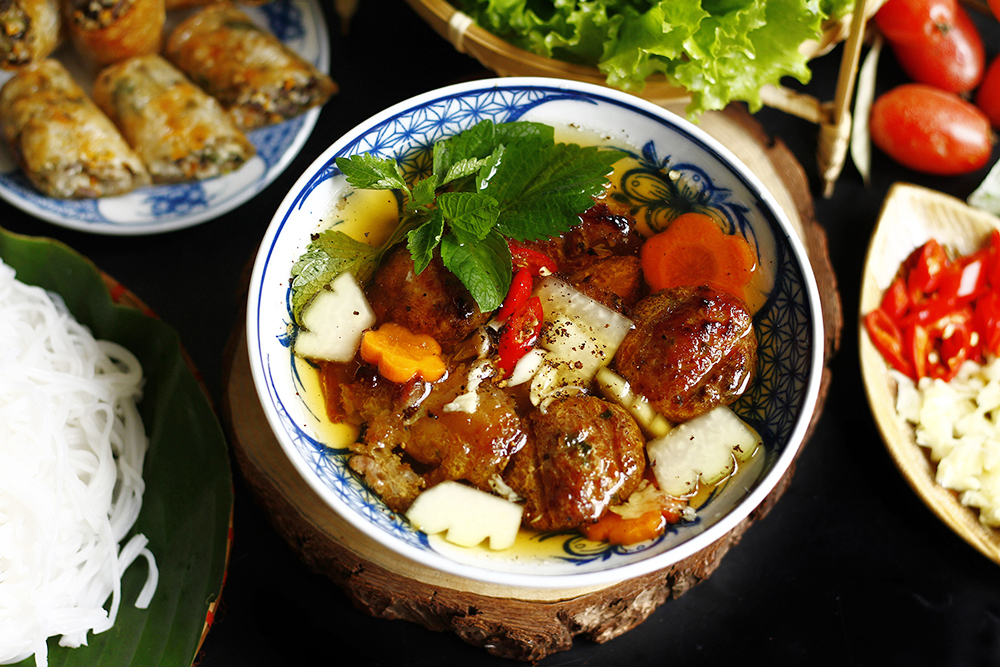
The preparation of Bun Cha is an art form in itself, where traditional methods ensure that the dish retains its authentic flavor while creating a sensory experience for diners.
The first step in preparation is marinating the pork. For the grilled pork patties, combining ingredients like ground pork, fish sauce, and spices leads to a mixture that is both flavorful and aromatic. After marination, the patties are hand-formed and set aside, allowing the flavors to meld beautifully. For the pork belly, thin slices are marinated in a similar mix, adding layers of flavor. Both types of pork can be grilled over charcoal, a traditional method that imparts an irresistible smoky charm.
Charcoal grilling is a hallmark of Bun Cha preparation. This technique involves setting up a charcoal grill and allowing the coals to reach the right temperature before placing the marinated pork on the grill. The outcome is meat that is tender on the inside and perfectly charred on the outside, creating an enticing aroma that invites you to take a bite.
The assembly of the dish follows as an artful endeavor. Diners have the freedom to combine the ingredients into their own unique bowls. The cooked vermicelli noodles serve as the base; diners layer on grilled pork and finish with an assortment of fresh herbs and pickled vegetables.
Serving Presentation:
This method of preparation and presentation not only enhances the dining experience but also adheres to the cultural norms of communal eating in Vietnam, fostering sharing and connection among diners.
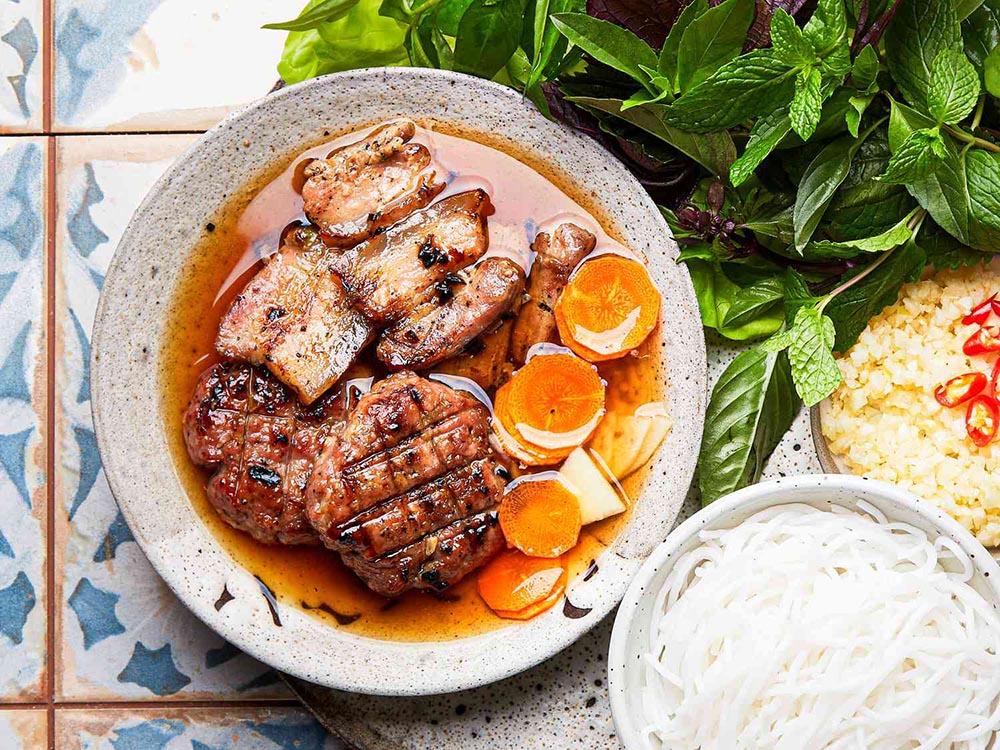
Bun Cha Ha Noi is deeply rooted in the historical culinary landscape of Vietnam, particularly symbolizing the communal spirit found in Hanoi. While the dish became popular in the 20th century, primarily through the thriving street food culture in the Old Quarter of Hanoi, its historical significance reflects more than mere sustenance; it embodies the essence of social connection and community spirit.
As an accessible dish, Bun Cha serves various social classes, making it integral to the culinary fabric of the city. Its affordability allowed both locals and tourists to enjoy a traditional Vietnamese meal without breaking the bank. This accessibility paved the way for numerous street vendors to set up shop, leading to the emergence of famous Bun Cha restaurants that define Hanoi's street food scene today.
Moreover, the dish gained international attention during a historic meal served by none other than former U.S. President Barack Obama and chef Anthony Bourdain in 2016. This occasion not only brought global recognition to Bun Cha but also emphasized the cultural and social significance of sharing a meal together. The image of President Obama enjoying a bowl of Bun Cha became emblematic of the dish’s role in connecting people across cultures and borders.
Overall, Bun Cha is a reminder of Hanoi's rich culinary heritage, and its place in Vietnam's historical narrative echoes through generations. It serves not only as a meal but as a testament to the enduring bonds formed around food, reflecting the country's vibrant social tapestry.
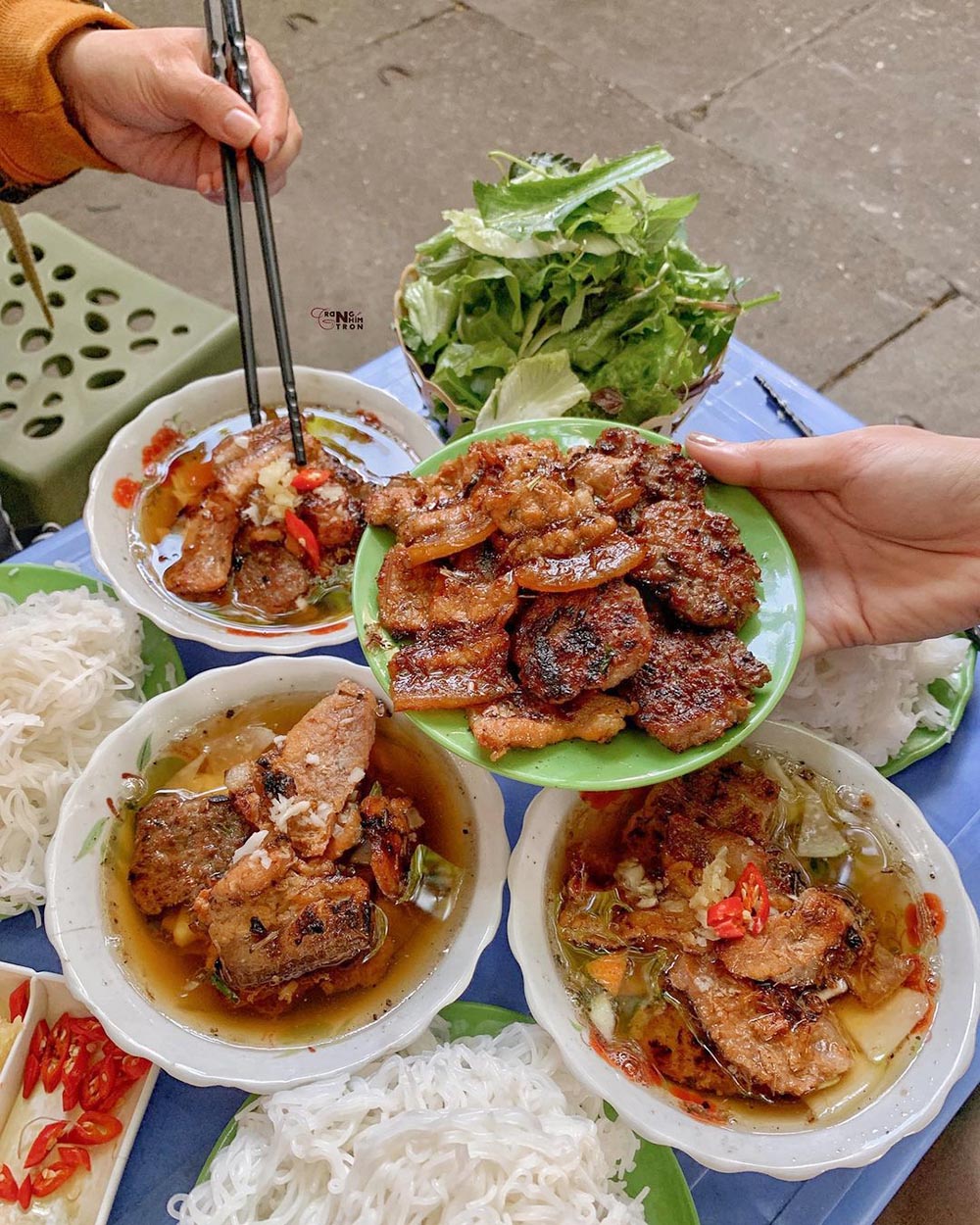
The origins of Bun Cha can be traced back to the bustling streets of Hanoi, where the dish emerged as a beloved street food staple. While its exact beginnings may be difficult to pinpoint, it is widely believed that Bun Cha gained prominence during the 20th century, becoming a popular choice among locals and merchants alike.
Hanoi’s Old Quarter is often credited as the birthplace of Bun Cha, where it thrived amidst the fast-paced rhythm of urban life. Street vendors honed the art of grilling pork over charcoal, allowing the smoky flavors to infuse the delicate meats, attracting passersby with their enticing aromas. Traditionally, the dish emerged as a simple yet hearty meal, with locals enjoying it alongside friends and family in communal settings, reflecting the Vietnamese ethos of togetherness.
As time progressed, Bun Cha evolved into a culinary icon, drawing both locals and international visitors to its tantalizing flavors. The diversity in preparation methods and presentation can still be seen today, where variations of Bun Cha exist alongside the traditional styles, catering to modern palates while maintaining cherished culinary practices.
The dish also embodies the resourcefulness of the Vietnamese people, who utilize local and readily available ingredients, resulting in a dish that is as sentimental as it is delicious. The continued evolution of Bun Cha, along with its enduring popularity, showcases its significance in representing the essence of Hanoi’s culinary heritage.
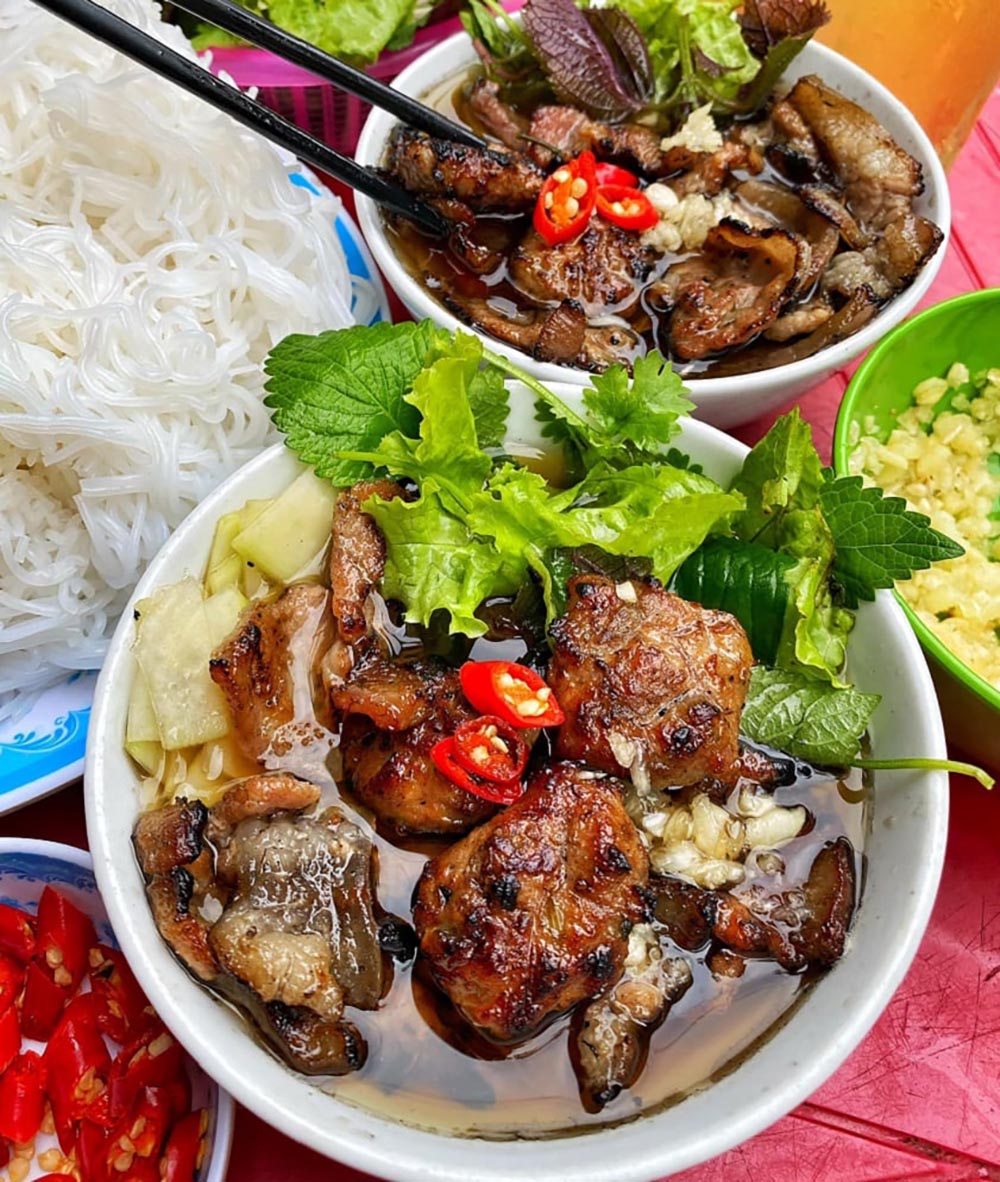
Bun Cha is more than just a dish; it’s a cultural phenomenon that reflects the soul of Vietnamese cuisine. The impact of Bun Cha in the culinary landscape of Vietnam is profoundly felt, as it captures the essence of shared meals, community bonding, and cultural identity.
Dining on Bun Cha is not merely about eating; it's an experience often characterized by circular tables filled with communal plates, fostering an atmosphere of togetherness. In countless homes and restaurants, families come together to enjoy this beloved meal, creating lasting memories over bowls of grilled pork and vermicelli. The shared act of eating Bun Cha encourages storytelling, laughter, and connection central tenets in Vietnamese culture.
Additionally, Bun Cha has become a symbol of Vietnamese heritage, recognized in culinary discourse both domestically and internationally. Its elevation to the global culinary stage, especially after the well-publicized meal shared between President Obama and chef Anthony Bourdain, has sparked a growing interest in Vietnamese cuisine as a whole. As more people discover and appreciate Bun Cha, they are also introduced to the rich tapestry of flavors and culinary techniques that define Vietnamese cooking.
Through food festivals, culinary tours, and international media attention, Bun Cha continues to play a significant role in promoting Vietnam's culinary identity, attracting food enthusiasts around the world. Its cultural significance encapsulates the tradition of dining, resonating with diners on a level that transcends flavors and ingredients, establishing Bun Cha as a true cultural emblem of Vietnam.
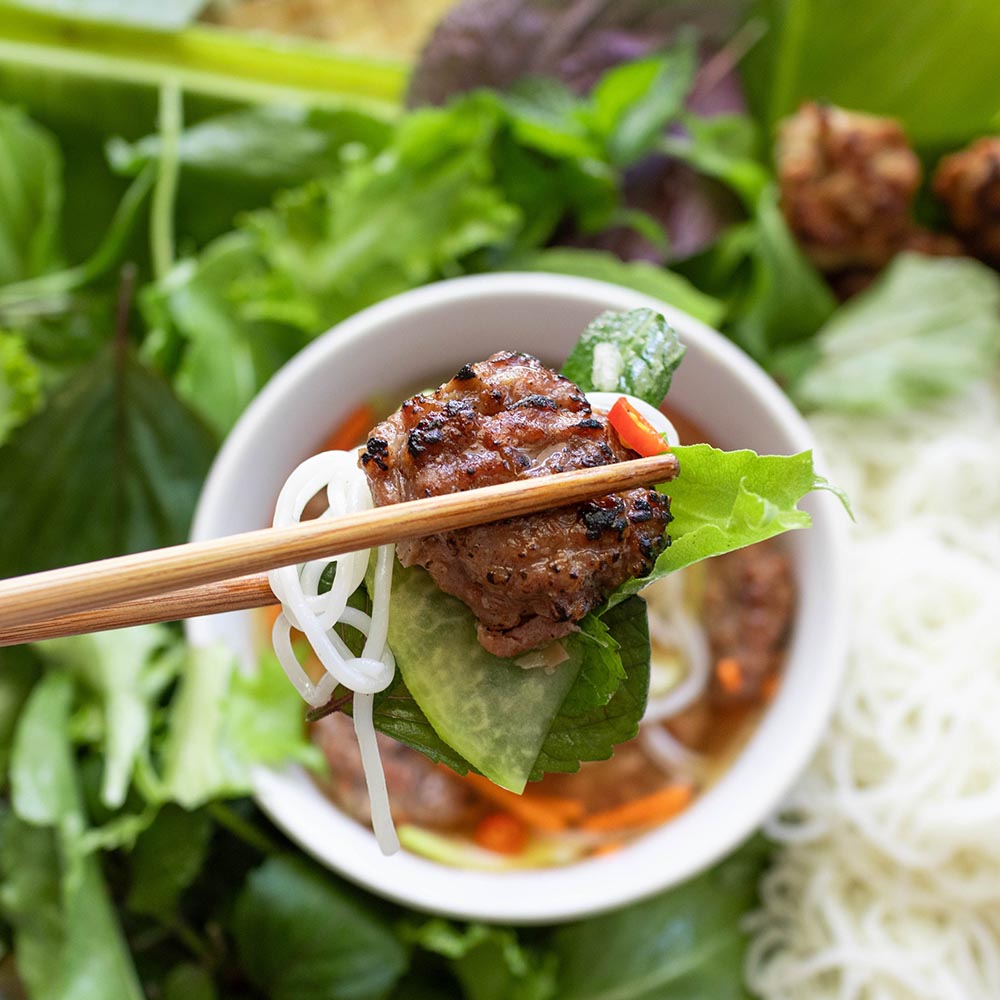
While Bun Cha Ha Noi is foundational in Vietnamese cuisine, various regions of the country have embraced the dish, each adding unique twists that celebrate local flavors and traditions. These regional variations highlight the culinary diversity within Vietnam, showcasing how one beloved dish can transform while retaining its core essence.
In the north, particularly in Hanoi, the dish features grilled fatty pork chả and bún, served with a fragrant dipping sauce. It is often accompanied by fresh herbs, offering a balance of flavors that speaks to the traditional cooking methods esteemed in Northern Vietnamese cuisine.
Traveling southward, the approach to Bun Cha begins to vary. In the south, Bun Cha may incorporate a wider selection of fresh herbs, with a touch of sweetness often characteristic of Southern Vietnamese dishes. Some southern variations include pickled vegetables or even serve Bun Cha alongside a crispy bánh mì (Vietnamese baguette), creating a heartier meal option with different textures.
Moving to the central region, Bun Cha can take on new elements with the inclusion of turmeric or different marinating techniques, leading to distinct flavors and appearances. These adaptations celebrate the unique local ingredients available and offer a glimpse into the regional food culture that exists across Vietnam.
These variations demonstrate the adaptability of Bun Cha while honoring its origins. Based on local tastes, traditions, and palates, Bun Cha continues to evolve while remaining a symbol of Vietnam’s rich culinary heritage.
The primary distinctions between Northern and Southern styles of Bun Cha lie in the ingredients, flavor profiles, and serving styles, reflecting the diverse culinary landscapes of Vietnam.
In the Northern style, the traditional essence of Bun Cha is honored with its focus on the quality of the grilled pork. The meat is marinated with a simple but effective mix of fish sauce, sugar, and pepper, allowing the natural flavors of the pork to shine through. The balance of the dish is achieved through the fresh herbs and the dipping sauce, which is equally as straightforward emphasizing the sour and salty characteristics familiar to Northern palates.
In contrast, Southern versions of Bun Cha elevate the experience with additional sweetness and complexity. The marinade might include more sugar, resulting in a slightly sweeter taste compared to its Northern counterpart. Southern Bun Cha may also feature a broader variety of herbs, incorporating local favorites that introduce bursts of flavor. The optional inclusion of crispy fried spring rolls adds a delightful crunch that enriches each bite.
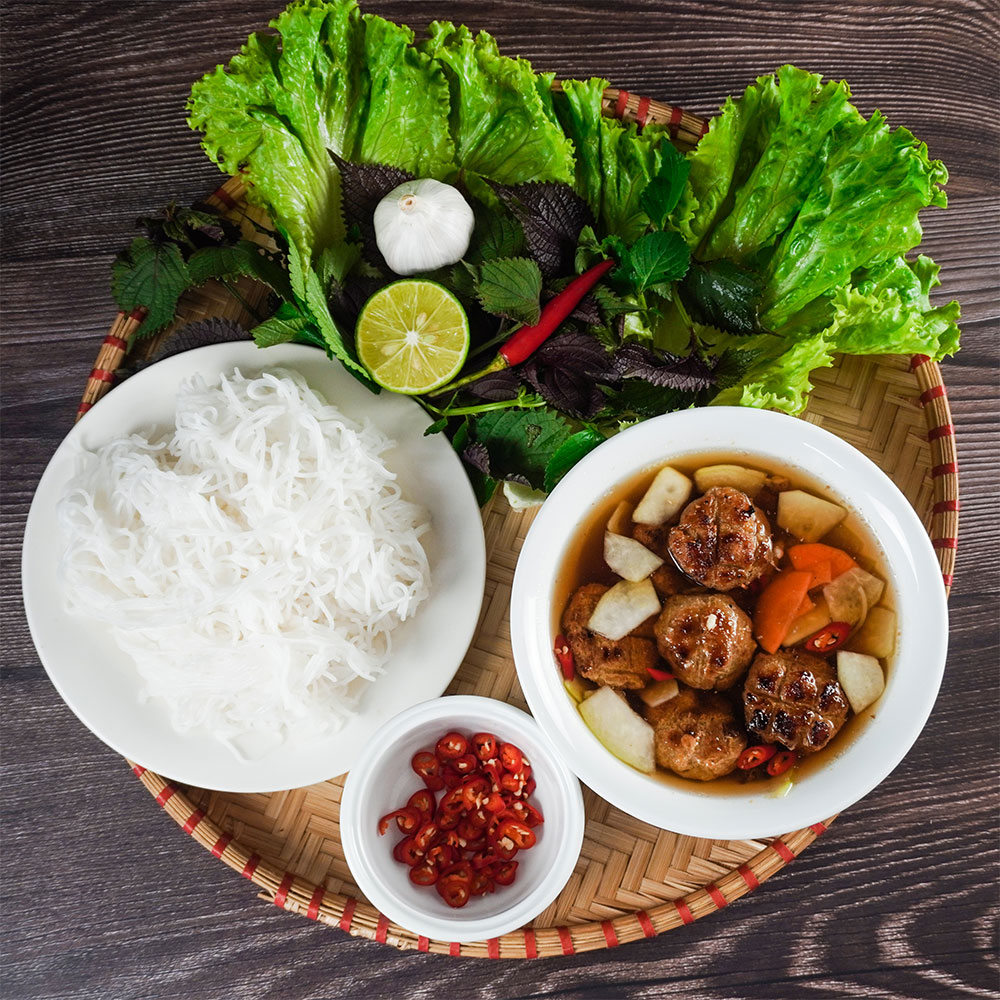
| Feature | Northern Style | Southern Style |
|---|---|---|
| Pork Preparation | Simple marinade focusing on pork's natural flavor | Complex marinade with added sweetness |
| Herbs Used | Limited variety (usually mint and cilantro) | Wider range includes basil, shiso, and more |
| Side Accompaniments | Pickled vegetables | Often served with fried spring rolls |
| Sauce Profile | Sour and salty with balanced notes | Sweeter profile with additional spices |
This divergence not only showcases regional preferences but also narrates the story of culinary evolution, celebrating Bun Cha’s flexibility and the diversity of Vietnamese cuisine.
The way Bun Cha is served varies greatly across different regions in Vietnam. Each locale adds its own flair, reflecting local tastes and food culture, thereby enriching the overall experience.
In Hanoi, Bun Cha is typically served in a communal setting, where dishes of grilled pork, vermicelli noodles, and fresh herbs are placed on the table, allowing diners to customize their bowls. The grilled pork is presented hot and steaming, alongside a dipping sauce that diners can adjust to their liking. This style fosters interaction, as families and friends share the meal in a traditional communal dining experience.
When traveling to Southern Vietnam, you may find that Bun Cha comes in more individualized portions, often on separate plates rather than being served family style. The emphasis on presentation becomes more pronounced, with the different components plated artistically. It’s common to see Bun Cha served alongside crisp vegetables or even crispy fried spring rolls, adding textural diversity.
In Central Vietnam, the service style may include unique presentation, such as serving Bun Cha in a flavorful broth, enhancing flavors further and allowing diners to enjoy the dish in a different context. Additional elements, such as turmeric seasoning, might be incorporated, changing the dish's signature look and taste profile.
As seen in these various serving styles, the adaptation of Bun Cha across regions exemplifies the dynamic nature of Vietnamese cuisine, where dishes evolve while still maintaining a connection to their roots.
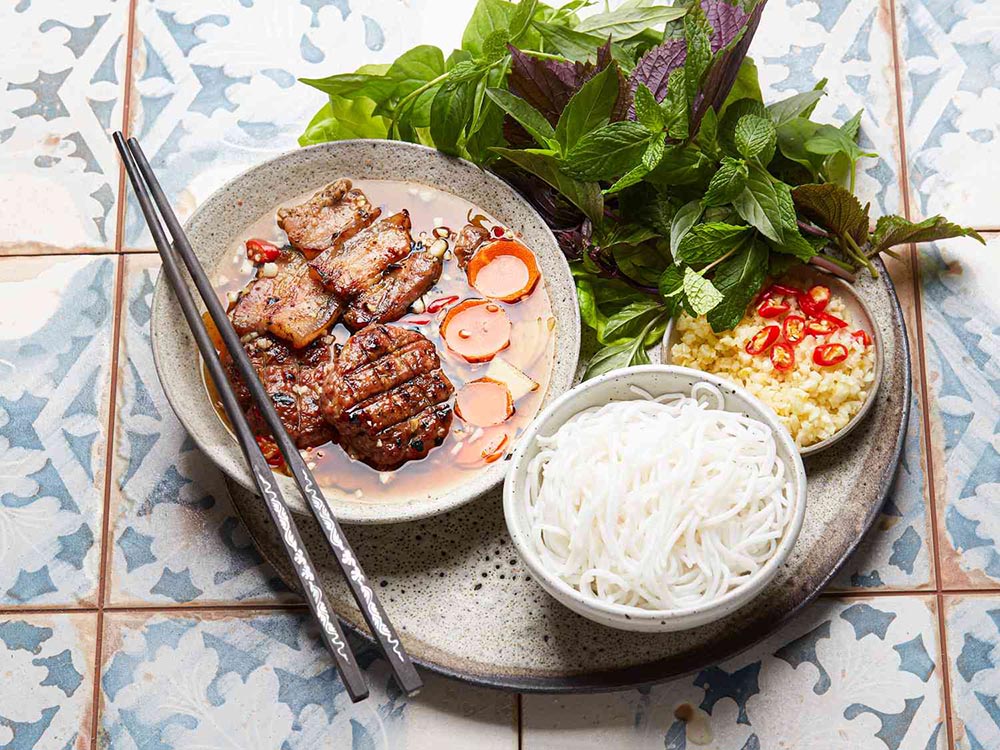
As a culinary staple, Bun Cha Ha Noi can be found in numerous establishments throughout the city. These restaurants offer a memorable dining experience, showcasing the rich flavors and textures of this iconic dish. Here are several popular destinations that specialize in Bun Cha:
Bun Cha Huong Lien - Located at 24 Le Van Huu, this restaurant gained international fame after hosting President Obama during his visit to Hanoi. Known for its delicious grilled pork, diners can savor the perfect balance of sweet and sour dipping sauce. Prices range from 40,000 to 60,000 VND per portion, and it operates from 10 AM to 7 PM.
Bun Cha Tuyet - Situated at 34 Hang Than Street, this establishment is famous for its family recipe, offering three different types of grilled pork. The unique blend of flavors in the dipping sauce makes each bowl a delightful experience. It operates from 7 AM to 5 PM, with prices between 35,000 and 55,000 VND.
Bun Cha Dac Kim - Located at 1 Hang Manh, this iconic spot is renowned for generous servings and top-quality ingredients. Each set costs around 3-4 USD and features various pork types, making it a favorite for both locals and tourists.
Bun Cha 41 - Found at 41 Cua Dong Street, this busy restaurant offers plentiful portions and reasonable prices about 50,000 VND per serving. This eatery is particularly crowded during lunch hours.
These establishments not only showcase the greatness of Bun Cha but also reflect Hanoi's rich culinary heritage, making them must-visit spots for food enthusiasts.
When seeking authentic Bun Cha in Hanoi, several renowned restaurants stand out, each offering its unique take on this beloved dish. Here are a few famous locations known for serving some of the best Bun Cha in the city:
Bun Cha Huong Lien: A must-visit, this restaurant gained international acclaim after President Obama dined here. It is known for its savory grilled pork, perfectly paired with a flavorful dipping sauce. The prices are reasonable, typically ranging from 40,000 to 60,000 VND.
Bun Cha Dac Kim: Celebrated for its generous portions and quality ingredients, Bun Cha Dac Kim is popular among locals and travelers alike. Located at 1 Hang Manh, each set is priced around 3-4 USD, showcasing the balance of flavors that Bun Cha is known for.
Bun Cha Tuyet: Located at 34 Hang Than, this eatery is famous for its family recipe, featuring a delicious blend of grilled pork types. The sauce blends sweet, sour, and salty flavors, creating a delightful dining experience. Prices generally range between 35,000 and 55,000 VND.
Bun Cha 41: This bustling spot at 41 Cua Dong Street is a favorite for its plentiful servings, with prices around 50,000 VND. The restaurant is often packed during lunch hours, reflecting its popularity among locals.
These establishments allow diners to experience authentic Bun Cha in settings that embody the vibrant essence of Hanoi's culinary scene.
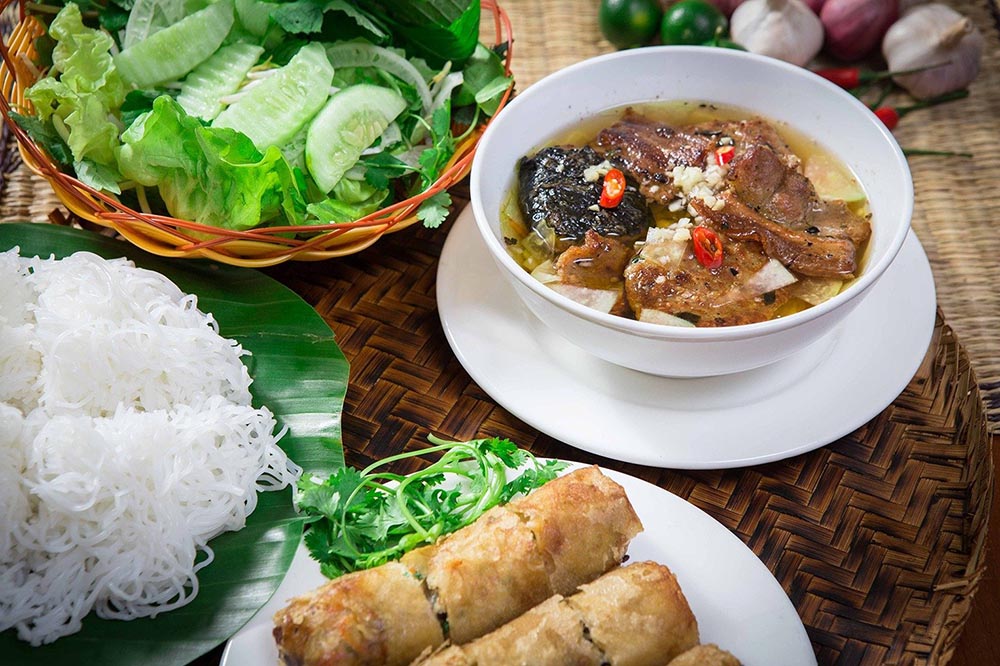
When exploring Hanoi's culinary landscape, making time for Bun Cha is a must. Here are some noteworthy local eateries where you can savor this iconic dish:
Bun Cha Huong Lien: As previously mentioned, this restaurant earned global recognition after being featured by President Obama. Their signature grilled pork is a highlight and perfectly complemented by their dipping sauce. Expect to pay around 40,000 to 60,000 VND per bowl.
Bun Cha Dac Kim: Known for generous servings of grilled pork and high-quality ingredients, this restaurant at 1 Hang Manh is a local favorite. Customer reviews rave about the tenderness and flavor of their grilled meats.
Bun Cha Tuyet: Located at 34 Hang Than, Vermicelli noodles and grilled pork at Bun Cha Tuyet come together harmoniously, with a unique dipping sauce that resonates well with diners. Prices are very affordable, ranging from 35,000 to 55,000 VND.
Bun Cha 41: A bustling eatery at 41 Cua Dong, Bun Cha 41 is favored for plentiful portions and wallet-friendly prices around 50,000 VND. It is an ideal stop for those craving an authentic Hanoi dining experience.
These local eateries not only offer a delicious meal but also immerse diners in the rich and diverse food culture of Hanoi, making them perfect spots to relish Bun Cha.
Eating Bun Cha in Hanoi is not just a meal; it is an invitation to dive into the vibrant street food culture of the city. As you approach a Bun Cha stall or restaurant, the enticing aroma of grilled meat fills the air, immediately awakening your appetite. The experience of savoring this iconic dish is enhanced by the flavors, textures, and communal atmosphere surrounding it.
When you sit down to enjoy a bowl of Bun Cha, the presentation reflects its rich culinary heritage. Grilled pork is served alongside fresh herbs, vermicelli, and a tangy dipping sauce, each component waiting to be harmoniously combined in your bowl. The smoky sweetness of the grilled meat contrasts beautifully with the refreshing taste of herbs like mint and cilantro, creating a culinary symphony that delights the palate.
As you take your first bite, the interplay between the textures becomes evident. The tender, juicy slices of pork paired with the chewy vermicelli provide a satisfying mouthfeel, while the crispy pickled vegetables offer an enjoyable crunch. Dipping the pork or noodles into the rich nước chấm elevates the flavors even further, striking a balance between savory, sweet, and sour.
Bun Cha is often consumed in a communal setting, where friends and family gather to enjoy bowls together, emphasizing the significance of sharing meals in Vietnamese culture. This lively atmosphere, combined with the flavorful experience of Bun Cha, makes it an unforgettable culinary adventure that connects people through food.
The culinary experience of enjoying Bun Cha is not solely defined by its main components; the traditional accompaniments play an equally significant role in amplifying the dish's flavors and textures.
Fresh Herbs: One of the most defining accompaniments to Bun Cha is the variety of fresh herbs served alongside the dish. Common options include mint, cilantro, and perilla. These herbs contribute bright, fresh notes that help cut through the rich flavors of the grilled pork. Diners often mix these herbs into their bowl or wrap them around the pork and noodles, enhancing each bite with vibrant flavors.
Pickled Vegetables: Another essential component includes a selection of pickled vegetables, primarily carrots and daikon. These vegetables add a tangy crunch that complements the savory pork and balances the overall flavor profile of the dish. The sweet-and-sour contrast of the pickled vegetables creates an enjoyable experience, inviting diners to appreciate diverse textures in one bowl.
Fried Spring Rolls (Nem): While not traditionally included, some variations of Bun Cha are served with nem, crispy fried spring rolls. This addition invites an extra layer of flavor and crunch, creating a more complex culinary experience for diners. The combination of soft noodles, tender pork, fresh herbs, and crispy spring rolls is a celebration of Viennese cuisine's diversity.
Overall, the traditional accompaniments enrich the experience of Bun Cha, ensuring that each bite surprises and delights the taste buds.
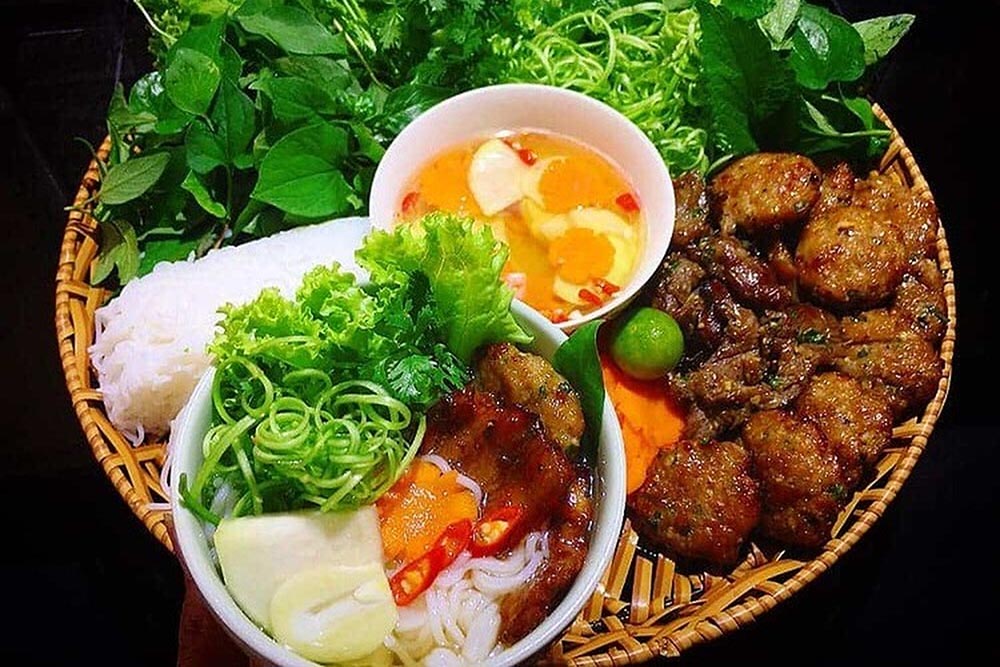
To fully appreciate the deliciousness of Bun Cha Ha Noi, here are essential tips for enjoying this iconic dish:
Assemble Your Bowl Properly: Start by taking a portion of cooked vermicelli noodles and placing them at the bottom of your bowl. Top with grilled pork patties and slices of pork belly, letting the flavors meld together beautifully.
Utilize the Dipping Sauce: The nước chấm is a key element of your Bun Cha experience. Mix together the components of the dipping sauce fish sauce, lime juice, sugar, and chili to achieve an optimal balance of flavors. Don't hesitate to dip your pork or noodles into the sauce and drizzle some over your ingredients for an enhanced flavor profile.
Incorporate Fresh Herbs: Fresh herbs are essential for balancing the richness of the pork. Add a generous handful of herbs like mint, cilantro, or perilla to your bowl, mixing them with the noodles and pork for a refreshing experience.
Consider Textures: Create an ideal bite by combining grilled pork, noodles, fresh herbs, and pickled vegetables for a multi-textural experience. The chewy noodles, tender pork, and crisp vegetables create a delightful contrast, elevating each mouthful.
Embrace the Communal Aspect: Eating Bun Cha is often enjoyed best in a communal setting. Share the dish with friends or family, fostering connections and celebrating the spirit of togetherness that is integral to Vietnamese dining culture.
By following these tips, you can fully immerse yourself in the Bun Cha experience, appreciating the rich traditions and flavors of this beloved Vietnamese dish.
1. What is Bun Cha?
Bun Cha is a traditional Vietnamese dish originating from Hanoi, featuring grilled pork, vermicelli noodles, fresh herbs, and a tangy dipping sauce known as nước chấm.
2. What types of pork are used in Bun Cha?
Bun Cha typically includes grilled pork patties (chả) and grilled pork belly, both marinated and grilled to develop rich flavors.
3. Are there any variations of Bun Cha across different regions in Vietnam?
Yes, there are regional variations of Bun Cha, with Northern styles focusing on simplicity and smokiness, while Southern styles may incorporate sweeter flavors and additional accompaniments like fried spring rolls.
4. What are the essential accompaniments when enjoying Bun Cha?
Essential accompaniments include fresh herbs, pickled vegetables, and often fried spring rolls, all contributing to a balanced and delightful dining experience.
5. Can Bun Cha be enjoyed by vegetarians or vegans?
While traditional Bun Cha features pork, some establishments may offer vegetarian or vegan versions using plant-based ingredients that mimic the flavors of the original dish, promoting inclusivity for diverse diets.
Bun Cha Ha Noi stands as a treasured culinary emblem of Vietnam, melding flavors, history, and community. With deep roots in Hanoi's rich food culture, this dish serves not just as a delicious meal but as a conduit for connection among those who share it. Emphasizing grilled pork, rice vermicelli, and vibrant herbs, Bun Cha is a harmonious blend of elements that celebrate the balance between savory, sweet, and fresh. The openings to explore local variations and regional adaptations provide an intriguing glimpse into Vietnam's culinary diversity. Whether enjoyed on the bustling streets of Hanoi, in cozy family gatherings, or as an international sensation, Bun Cha has established itself as a joyful celebration of Vietnamese gastronomy. In every bite, diners are reminded that food is a universal language, capable of bridging cultures and forging bonds, making Bun Cha a dish to savor and cherish for generations to come.